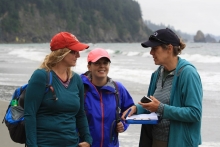
By: Sherry Lippiatt, California Regional Coordinator for the NOAA Marine Debris Program
On July 15th, an intrepid group of shoreline survey enthusiasts departed Seattle for nearly a week on the road. The mission: to spend a full six days surveying West Coast beaches for marine debris. The goal of this “surveypalooza” was to compare shoreline survey methodologies developed by the NOAA Marine Debris Program (MDP; for the Marine Debris Monitoring and Assessment Project, or “MDMAP”) and the Australian Commonwealth Scientific and Industrial Research Organisation (CSIRO). All told, our team of eight (including staff from the MDP, CSIRO, and the Ocean Conservancy) completed 26 individual monitoring surveys at 16 shoreline sites located approximately every 100 km along the coasts of Washington, Oregon, and Northern California.
Monitoring shorelines for marine debris can help answer some important questions, such as: how big is the marine debris problem, and how is it changing over time? Or, what types of debris are most common in a region? There are a lot of questions that drive monitoring efforts, but developing a standardized monitoring protocol is not so straightforward.